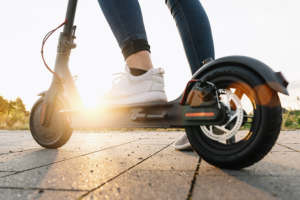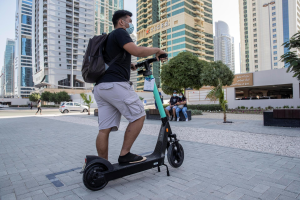It’s not advisable to leave your electric scooter in the sun, as it can damage the battery and degrade materials over time.
The Effects of Sun Exposure on Electric Scooters
Extended exposure to sunlight can significantly impact the overall functionality and lifespan of electric scooters. This section explores the key areas affected by the sun, including battery life and performance, as well as the materials and components of the scooter.

Impact on Battery Life and Performance
One of the most crucial components of an electric scooter is its battery. When exposed to high temperatures, the chemical reactions within lithium-ion batteries accelerate. This not only reduces the battery’s efficiency but also diminishes its overall lifespan. For instance, a battery that typically lasts for 500 charging cycles might see a reduction to just 300 cycles if consistently exposed to high temperatures.
Efficiency: High temperatures can lead to a decrease in battery efficiency. Normally, a fully charged electric scooter might have a range of 30 kilometers, but this can reduce by up to 10-15% in extreme heat.
Costs: The reduction in battery life can lead to increased costs over time. Replacing a scooter battery might cost anywhere from $100 to $300, depending on the model and specifications.
Effects on Scooter Materials and Components
Sun exposure also impacts the physical materials of the scooter. UV radiation can cause plastic components to degrade, leading to brittleness and color fading. This not only affects the scooter’s appearance but also its structural integrity.
- Materials: Materials like rubber and plastic are particularly vulnerable. For example, the scooter’s tires and handlebar grips might degrade faster, affecting both the safety and aesthetics of the scooter.
- Lifespan: Continuous exposure to the sun can reduce the overall lifespan of these materials. A scooter that might typically last for 3-4 years could have its lifespan reduced by up to 30-40% if left in the sun regularly.
Best Practices for Electric Scooter Storage
Proper storage of electric scooters is essential to maintain their functionality and extend their lifespan. This guide covers the ideal conditions for storing your scooter and provides practical tips for outdoor storage.
Ideal Storage Conditions for Longevity
Creating the right environment for storing an electric scooter can significantly impact its longevity. Key factors include temperature control, humidity, and physical protection.
Temperature Control: Store the scooter in a cool, dry place where temperatures remain consistent. Ideal storage temperatures range from 10°C to 25°C. Extreme cold or heat can affect battery performance and lifespan.
Humidity Levels: Ensure the storage area has low humidity to prevent corrosion and electrical issues. Aim for a humidity level below 50%.
Physical Protection: Keep the scooter away from direct sunlight and water exposure. If storing in a garage or shed, ensure it’s placed where it won’t get knocked over or have objects fall on it.
Tips for Outdoor Scooter Storage
Sometimes, indoor storage isn’t an option. Here are tips for safely storing your electric scooter outdoors:
- Use a Protective Cover: Invest in a high-quality, waterproof cover to protect your scooter from rain, sun, and dust. This cover should be breathable to prevent moisture buildup.
- Secure Location: Choose a secure area to minimize the risk of theft or vandalism. Use a sturdy lock to secure the scooter.
- Avoid Constant Sunlight: Even when covered, try to position the scooter in a shaded area to minimize heat and UV radiation exposure, which can degrade the scooter’s materials and battery.
Managing Battery Health in Extreme Temperatures
Ensuring the health of an electric scooter’s battery is crucial, especially when dealing with extreme temperatures. This section delves into strategies for protecting the battery from heat damage and provides specific tips for charging in hot weather.
Protecting the Battery from Heat Damage
Heat can be detrimental to the health and efficiency of electric scooter batteries. Here are key practices to protect your battery:
Avoid Direct Sunlight: Store your electric scooter in a shaded area. Prolonged exposure to direct sunlight can increase the battery’s internal temperature, leading to reduced efficiency and potential cell damage.
Monitor Temperature Conditions: Keep an eye on the ambient temperature. Electric scooter batteries operate best at temperatures between 20°C and 25°C. Exposure to temperatures above 30°C can accelerate battery degradation.
Insulate the Battery: Consider using insulation materials to shield the battery from extreme heat. However, ensure there’s adequate ventilation to prevent overheating.
Charging Tips for Hot Weather
Charging your electric scooter in hot weather requires extra precautions to maintain battery health:
- Avoid Charging in High Heat: Charge your scooter during cooler parts of the day or in a temperature-controlled environment. Charging batteries in high temperatures can reduce their lifespan and efficiency.
- Use the Right Charger: Always use the manufacturer-provided charger. Using an inappropriate charger can lead to overheating and even pose a fire risk.
- Monitor the Charging Process: Keep an eye on the battery temperature during charging. If the battery becomes too hot to touch, it’s advisable to stop charging and let it cool down before resuming.
Safety Considerations for Electric Scooters in the Sun
Riding and maintaining electric scooters in sunny conditions comes with specific safety considerations. This section focuses on understanding the potential risks associated with sun exposure and provides tips for using your scooter safely on hot days, along with maintenance advice for scooters exposed to the sun.
Potential Risks and Precautions
Sun exposure, particularly in extreme heat, poses several risks to both the scooter and the rider:
- Overheating of Components: Continuous exposure to sunlight can cause the scooter’s motor and battery to overheat, affecting performance and safety.
- Tire Pressure Fluctuations: Heat can cause the air inside the tires to expand, leading to overinflation. This can affect the scooter’s handling and increase the risk of tire bursts.
- Precautions: To mitigate these risks, park the scooter in shaded areas, check tire pressure regularly, and allow the scooter to cool down after prolonged use in the sun.
How to Safely Use Your Scooter on Hot Days
Using an electric scooter during hot days requires careful consideration:
Stay Hydrated: Ensure you stay hydrated, as riding in the heat can lead to dehydration.
Wear Appropriate Clothing: Protect yourself from sunburn and heat stroke by wearing light, breathable clothing, sunglasses, and sunscreen.
Plan Your Route: Prefer routes with shade and avoid the hottest parts of the day for longer journeys.

Maintenance Tips for Sun-Exposed Electric Scooters
Regular maintenance is crucial for scooters frequently used or parked in the sun:
Routine Checks and Cleaning
Regular Inspections: Regularly inspect the scooter for signs of sun damage, such as fading colors, cracks, or brittle plastic and rubber parts.
Cleaning: Clean the scooter regularly to remove dust and debris that can accumulate more quickly in hot, dry conditions.
Repair and Replacement of Heat-Damaged Parts
Battery Care: Check the battery’s performance and look for signs of overheating or swelling.
Component Replacements: Be prepared to replace sun-damaged parts, such as tires or grips, which can degrade faster due to UV exposure.
Professional Checkups: Consider a professional service checkup if you notice any significant changes in performance, especially after prolonged exposure to heat.
How does sun exposure affect an electric scooter's battery life?
Can high temperatures damage the electric scooter's motor?
What are the best practices for charging an electric scooter in hot weather?
Can I ride my electric scooter in extremely hot weather?
